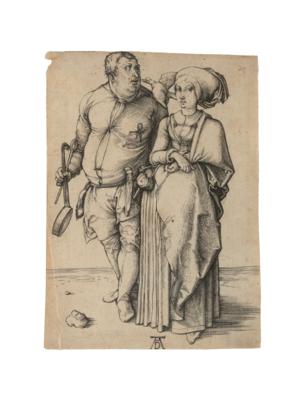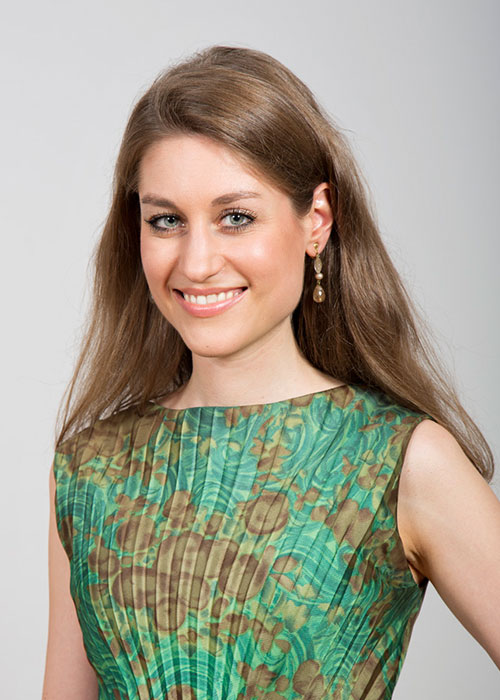Albrecht Dürer

(Nuremberg 1471–1528)The Cook and His Wife, ca. 1496, engraving on laid paper, monogrammed AD in the plate, 10,8 x 7,7 cm, trimmed along and within framing lines, old mount, Bartsch 94, Meder 95 a (of e), mounted, framed, (Sch)
Provenance:
Collection of Louis Baron von Rothschild (1882-1955), Waidhofen/Ybbs, Inv. No. 784;
seized in 1938;
Restitution to Louis Baron von Rothschild 1947;
Inherited by his spouse Hilda Baronin von Auersperg-Rothschild nee Princess of Auersperg (1894-1981), 1955;
her heirs
Very excellent, clear impression of the first state Meder a (of e), with fine lines, prior to the wiping marks. A repaired tear to left margin and a loss at upper left corner, otherwise in a very good condition. Rare in this early state.
The depiction of an odd-looking couple in the present engraving is one of Dürer's earliest genre prints. It was made in ca. 1496. In literature, the motif is traditionally referred to as "The Cook and His Wife." However, upon closer inspection of the two figures, the title may not be entirely accurate, as Hausmann noted already in 1861. He described the sheet more precisely as "Die Wirtin und der Koch" (“The inn-keeper and the cook” cf. B. Hausmann, Albrecht Dürer's engravings, etchings, woodcuts and drawings, Hannover 1861, no. 84). The story behind the depiction and the meaning of the two figures is not clearly understood even to the present day. In any case, the figures are probably more than mere costume studies;
they may have been executed as an illustration for a tale or a proverb following a literary model. Bartsch mentions the "The Book of the Night of the Tower" by Goeffrey de la Tour Landry (1493) as a possible source: Its story is about a wife who was betrayed by a magpie because she had eaten an eel which was promised to her husband. However, the bird depicted is not a magpie, nor is there any mention of a cook in the book. The figure of the cook may have been inspired by Mantegna's "Bacchanal with Silen", which Dürer copied in 1494. The elegant appearance of the woman in a bourgeois dressing gown and her bonnet indicating that she was married contrast with the frowsy clothing of the unkempt man, who proudly presents a cooking spoon and a frying pan in his right hand as attributes of his status. The woman, on the other hand, wears keys and a pouch on her belt, which are the traditional attributes of the housewife, who in posture and with her sly side glance demonstrates superiority. The bird on the cook's shoulder may also represent a cuckoo, which in medieval depictions such as "Frau Minne" pointed to male foolishness. The present engraving is therefore probably to be read as an apt satire of class and gender, or as Schoch put it, as a manifestation of the "power of women". (cf. R. Schoch / M. Mende / A. Scherbaum, Albrecht Dürer, Das druckgraphische Werk, Vol. I, Cat. 13, p. 55).
Expert: Mag. Astrid-Christina Schierz
 Mag. Astrid-Christina Schierz
Mag. Astrid-Christina Schierz
+43-1-515 60-546
astrid.schierz@dorotheum.at
20.04.2022 - 15:04
- Dosažená cena: **
-
EUR 28.160,-
- Odhadní cena:
-
EUR 8.000,- do EUR 10.000,-
- Vyvolávací cena:
-
EUR 8.000,-
Albrecht Dürer
(Nuremberg 1471–1528)The Cook and His Wife, ca. 1496, engraving on laid paper, monogrammed AD in the plate, 10,8 x 7,7 cm, trimmed along and within framing lines, old mount, Bartsch 94, Meder 95 a (of e), mounted, framed, (Sch)
Provenance:
Collection of Louis Baron von Rothschild (1882-1955), Waidhofen/Ybbs, Inv. No. 784;
seized in 1938;
Restitution to Louis Baron von Rothschild 1947;
Inherited by his spouse Hilda Baronin von Auersperg-Rothschild nee Princess of Auersperg (1894-1981), 1955;
her heirs
Very excellent, clear impression of the first state Meder a (of e), with fine lines, prior to the wiping marks. A repaired tear to left margin and a loss at upper left corner, otherwise in a very good condition. Rare in this early state.
The depiction of an odd-looking couple in the present engraving is one of Dürer's earliest genre prints. It was made in ca. 1496. In literature, the motif is traditionally referred to as "The Cook and His Wife." However, upon closer inspection of the two figures, the title may not be entirely accurate, as Hausmann noted already in 1861. He described the sheet more precisely as "Die Wirtin und der Koch" (“The inn-keeper and the cook” cf. B. Hausmann, Albrecht Dürer's engravings, etchings, woodcuts and drawings, Hannover 1861, no. 84). The story behind the depiction and the meaning of the two figures is not clearly understood even to the present day. In any case, the figures are probably more than mere costume studies;
they may have been executed as an illustration for a tale or a proverb following a literary model. Bartsch mentions the "The Book of the Night of the Tower" by Goeffrey de la Tour Landry (1493) as a possible source: Its story is about a wife who was betrayed by a magpie because she had eaten an eel which was promised to her husband. However, the bird depicted is not a magpie, nor is there any mention of a cook in the book. The figure of the cook may have been inspired by Mantegna's "Bacchanal with Silen", which Dürer copied in 1494. The elegant appearance of the woman in a bourgeois dressing gown and her bonnet indicating that she was married contrast with the frowsy clothing of the unkempt man, who proudly presents a cooking spoon and a frying pan in his right hand as attributes of his status. The woman, on the other hand, wears keys and a pouch on her belt, which are the traditional attributes of the housewife, who in posture and with her sly side glance demonstrates superiority. The bird on the cook's shoulder may also represent a cuckoo, which in medieval depictions such as "Frau Minne" pointed to male foolishness. The present engraving is therefore probably to be read as an apt satire of class and gender, or as Schoch put it, as a manifestation of the "power of women". (cf. R. Schoch / M. Mende / A. Scherbaum, Albrecht Dürer, Das druckgraphische Werk, Vol. I, Cat. 13, p. 55).
Expert: Mag. Astrid-Christina Schierz
 Mag. Astrid-Christina Schierz
Mag. Astrid-Christina Schierz
+43-1-515 60-546
astrid.schierz@dorotheum.at
|
Horká linka kupujících
Po-Pá: 10.00 - 17.00
kundendienst@dorotheum.at +43 1 515 60 200 |
| Aukce: | Mistrovské kresby, Tisky do roku 1900, Akvarely a miniatury |
| Typ aukce: | Online aukce |
| Datum: | 20.04.2022 - 15:04 |
| Místo konání aukce: | Wien | Palais Dorotheum |
| Prohlídka: | 13.04. - 20.04.2022 |
** Kupní cena bez kupní ceny a DPH
Není již možné podávat příkazy ke koupi přes internet. Aukce se právě připravuje resp. byla již uskutečněna.
